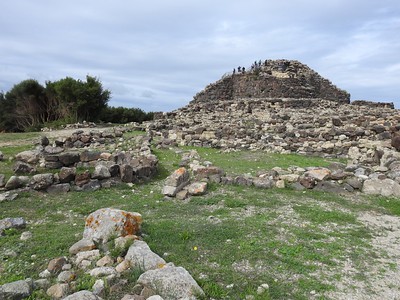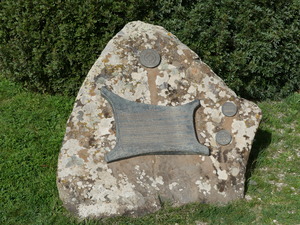Su Nuraxi di Barumini

Su Nuraxi di Barumini is the most important Bronze Age defensive structure of Sardinia.
The prehistoric settlement was centered around a three-story, megalithic 'nuraghe' tower that was built around 1500 BCE. The Nuraghi, originally isolated towers in prominent settings, were built to house single families or clans, but evolved into a more complex settlement for social and defensive reasons.
Community Perspective: Don’t look at it only from afar, but take the guided visit that is included with the ticket, as it will take you in and on the structure and add a lot of background info to the ‘heap of stones’. Ilya has recommended a few other Nuraghi that are worth visiting.

Map of Su Nuraxi di Barumini
Community Reviews
Ilya Burlak

I visited Su Nuraxi in September of 2023 on a self-driven tour around Sardinia. Due to the structure of my itinerary, Su Nuraxi was the fifth Nuragic site that I stopped by, so I already was well familiar with the key information points regarding the ancient civilization and its archetypal edifice. Because of that, I did not mind going on an Italian-language tour, starting within minutes of my arrival, as opposed to waiting for the next English-language tour. That I speak and understand Italian - passably, not fluently - obviously helped, but the relative familiarity with the subject helped even more.
The guide-led timed entry at Su Nuraxi - every half hour; the only nuraghe visited on this trip where we could not roam free - is partially justified by the fact that the interior parts of Su Nuraxi that you can step into are dark and small to the point of being claustrophobic; there are three narrow passages where traffic has to be limited to one person at a time in one direction. In fact, for all of its overall size and supposed exemplifying features, I did not find Su Nuraxi to be the most impressive of the nuraghi that I've seen specifically on the strength of its interior space constraints.
When you linger on elevated viewpoints of the central complex, you start to recognize that what looked from the ground like piles of stones are actually visible outlines of outer structures. Once the guide leads you back outside of the main tower and declares the tour to be over, you have about five minutes to step off the main path to explore those outer precincts on your own, where you come across a number of interesting details and sub-structures.
This single-location WH site may or may not become a serial site, but in case it does, I am including a brief description of the other 4 nuraghi that are part of the tentative list that we stopped by to see.
Santu Antine was the one that I would call the most impressive. Unlike at Su Nuraxi, its defined interior spaces actually allow proper exploration of the main structure, including several fairly walkable covered passages. It is hard to imagine that it would be overlooked for inclusion when and if the decision to extend comes along. (It is also more photogenic from the outside, IMHO.)
Palmavera is significantly more compact in its core, but its outer precincts are not far behind those at Su Nuraxi. There are a couple of uncommon surviving artifacts on the grounds, such as a sandstone nuraghe "model" on a circular altar and a stone chief's seat. Depending on how many locations are selected to be included on the extension list, it is questionable if it will make the cut.
Parco Archeologico Santa Cristina is a larger nuraghe+. Its central part is well-preserved remnants of a Christian village, centered on the church built on this site around 1200 CE. The nuraghe proper is located in a surprisingly wooded area a couple of hundred meters beyond the village. The central fortress here consists of a single truncated tower, while the rest has more of a feel of an archaeological dig, with only a few defined structure outlines. There is another roofed space that can be entered, however - a "barn".
Separated from the nuraghe by the aforementioned village - about half a kilometer away - is the sacred well temple; the triangular chiseled opening in the ground is clearly the killer feature of the park. I don't think the nuraghe is representative enough for the inclusion on the WH extension, but the well may further its case.
Finally, Sant'Anastasia is technically just a small archaeological site excavated around an 11th-century church. There is no nuraghe fortress/tower here. On maps, the place is called <em>Pozzo Sacro di Sant'Anastasia</em> - the sacred well - because its key feature beyond the church is also the Nuragic well temple, smaller, more ancient-looking, and with surprisingly a larger water reservoir than its counterpart at Santa Cristina. I doubt that Sant'Anastasia will make it on the final list of the WH extension, but I do know many other serial site locations that feel unworthy, so who knows.
We picked these sites due to their proximity to either our bases in Sardinia or our driving routes (Su Nuraxi, obviously, was directly targeted). Each requires between thirty minutes and an hour to see. Echoing Els's review, there are no good public transportation options to reach them, so driving is required. At sites other than Su Nuraxi, you can explore on your own, with the information provided either via a phone app, a booklet, a set of information stands, or sometimes by the otherwise unoccupied attendant.
Read more from Ilya Burlak here.
Els Slots

I finally gave up on public transport in Corsica & Sardinia at Barumini: there's no way to do it on a day trip by bus or train. Not that the experience of renting a car for a day was such a pleasure: I found the Hertz office at Cagliari-Elmas airport understaffed at 9 am, their printer did not work so they had to write my contract by hand (oh, I so wish for a full digital transformation of car rental companies) and the directions where to pick up my car were immensely vague. I guess the lady behind the desk had lost her sense of direction because of the stress. Together with a German tourist, I went on a thorough search for our cars, which we finally spotted after 20 minutes using a high vantage point. It turned out that there is an additional parking lot just in the shadow of the large parking garage.
All these delays meant that I could throw overboard the plans that I had to visit another site or two beside Su Nuraxi di Barumini. If you have your own wheels and a full day to spare from Cagliari, you could easily extend a trip to Barumini to the Sulcis Iglesiente TWHS and the Temple of Antas.
Fortunately, the visitor experience at Su Nuraxi di Barumini is exemplary. There’s free parking and a (book) shop. The 14 EUR entrance fee is steep, but in addition to entry to two museums in town it also provides employment to the guides and tours are frequent. Together with a German couple, I was given a tour in English within 20 minutes of my arrival. A guide is really necessary here because otherwise, it’s the proverbial ‘heap of stones’.
The prehistory of both Sardinia and Corsica is an interesting subject to contemplate while travelling in this part of the Mediterranean. There are findings from the Paleolithic in Sardinia and early Sardinians crossed the Strait of Bonifacio to Corsica around 9000 BC. In Corsica, I had already visited the archaeological sites of Filitosa and Cuccuruzzu-Capula. Both are really fun to explore, as they cover large areas and display those cute menhirs. These sites pre-date the Nuragic civilization, of which Su Nuraxi di Barumini is the showcase.
I like it that Barumini was chosen as the example to represent the nuraghe – had it been proposed in a later year we probably would have had a serial WHS called “Nuraghe of Sardinia” (there are 8,000 of them left). But this is the biggest, the best and it tells the story. There may be an extension on the radar though: Sardinia's nuragic culture.
The stones that define the image of Su Nuraxi di Barumini are not all related to the nuraghe / tower. Much of them belong to a later settlement that grew in the shadow of the then ruined tower and re-used stones from it. The guide brought a picture book showing the original shape of the tower. It looked like a medieval castle, with high ramparts and watchtowers. Stairs and plateaus were made of wood, which (except for one plank) have not been preserved. As with the other nuraghi in Sardinia, the top is gone. A modern wooden staircase has been installed to climb and look into the 3-story nuraghe itself. I found the solid building style particularly striking when seen in close up. The stones were stacked loosely, cement was still unknown. Smaller stones were used towards the top. Looking down from the top you see a courtyard with a well.
Jakob Frenzel

September 2009 - with my best schoolmates we decided to do an one week trip to Sardegna. After 2 days in Cagliari we rented a car and planned to drive around the Island. I had to pesuade them to go first up north to visit Sardegnas only whs. A pile of stones when looking from outside. But we did a tour going into the beehives, which was quite impressive. However, after the visit we drove back to the shore. An amazing place I can advise: Piscinas dunes on the westcoast. A memorable experience and the best we have seen on the island.
Clyde

I visited this WHS in March 2017. Having visited most of the 'beehive' sites on the list and knowing that the cost of this visit would be quite steep at 11 euros per person, I had low expectations.
Upon arriving at the Su Nuraxi parking lot, just outside the village of Barumini, I immediately spotted the highest nuragic structure and what seemed like circular structures which are quite similar to the ones of Choirokoitia in Cyprus. So to actually 'see' the site you can stroll by the street and view the nuragic site with the 15th century castle remains of Las Plassas in the background.
However, you'd be missing out on the very interesting guided walk through the nuragic complex and most importantly inside the nuragic 'fortress' which offers an unbeatable panoramic view of the whole site from the highest tower. Moreover, included in the entrance fee to this site are visits to Palazzo Zapata, which houses a limestone (whitish) nuraghe and several important remains found in Su Nuraxi and Centro Giovanni Lilliu which has an interesting collection of excavation photos and 3D models. The most important remain in Palazzo Zapata is the limestone model of a nuragic tower which was found in 'hut' 80 as it gives an idea of how the upper part of the towers must have looked like. It also helps to appreciate the signifance of the numbered basalt stones scattered around the site's perimeter which most probably belong to the uper parts of the towers.
The site bears no aesthetic beauty even though the surrounding green countryside in March is quite pleasant. However, compared to other similar sites on the list, this WHS is by far the most complete and the most important out of the over 7000 nuragic sites in Sardinia.
PS: bring sturdy shoes and comfortable clothes as you'll be climbing and crawling through some seriously narrow stairways and passages during your 1 hour guided visit. Visiting in the shoulder months also meant that we had a guide for ourselves and we were allowed to revisit and take photos alone after the guided visit. The UNESCO WHS inscription plaque is situated to your right once you enter through the wooden gate.
John booth

The Su Naraghi near Barumini have the distiction of forming one of the largest and most complete of these strange villages. The dwellings are conical in shape and constructed of dry stone boulders carefully wedged together.
The WHS is stuated 20 minutes walk from the village of Barumini. Although there are infrequent direct buses to and from Cagliari, I travelled to Barumini by train from Cagliari Republicca station to Isili on the Ferrovia de Sardegna railway. Then I caught a bus from Isili to Barumini.
Frans Boeijen
The site is very impressive and large. I was surprised one could go in, but this was only possible with a guide. There was no English speaking guide available, which made it hard to understand what we saw. With a little English book it was possible to understand some of it.
It was not difficult to find the site. I found it very worthwile visiting and would certainly recommend this to anyone visiting Sardinia. However the countryside was a bit disappointing...
Community Rating
- : Szucs Tamas Eva Kisgyorgy Tarquinio_Superbo
- : Tevity Paolo ZaK Bropyk Federico P.
- : Thomas Buechler Craig Harder Ivan Rucek Joyce van Soest Nasebaer Cosaflora Monchan5396 SirLoydd Bernard Joseph Esposo Guerrero Krijn Elia Vettorato Flexiear Martina Rúčková Yevhen Ivanovych
- : Randi Thomsen Philipp Peterer Xiquinho Silva Lesoruble Monica Tasciotti Mikko Zizmondka Dwight Zehuan Xiao MaxHeAnouBen Daniel C-Hazard Manuelfunk Astraftis CeeMon Ilya Burlak
- : Wojciech Fedoruk Els Slots Nan Jakob Frenzel Alexander Barabanov Merveil Vencisak Jonas Hagung JobStopar Jeanne OGrady
- : Zoë Sheng John Smaranda Philipp Leu Hubert Argo Svein Elias
- : Clyde Walter
Site Info
- Full Name
- Su Nuraxi di Barumini
- Unesco ID
- 833
- Country
- Italy
- Inscribed
- 1997
- Type
- Cultural
- Criteria
-
1 3 4
- Categories
- Archaeological site - Prehistoric
- Link
- By ID
Site History
1997 Inscribed
Site Links
Unesco Website
Official Website
Related
Connections
The site has 12 connections
Constructions
History
Religion and Belief
Timeline
Trivia
Visiting conditions
WHS Names
WHS on Other Lists
World Heritage Process
Visitors
136 Community Members have visited.
The Plaque
 (photo by Clyde)
(photo by Clyde)